
44 minute read
Relationship
Continuing Education In Times Of COVID - 19: Learning To Teach, Teaching To Learn; A Two-Way Relationship

by Venie Gaki, Middle School ESL/EFL Faculty
In April 2020, my thesis “Creating a sense of Home; the role of a social studies teacher in an international school in Greece. Fostering identity and inclusion” was submitted to the Hellenic American College as the end product of a long journey that was interrupted for personal reasons in 2007, a journey on which I embarked again ten years later, in 2017. My goal was finally achieved; my dream, which I had to digress from due to the multiple identities a woman of the 21st century is requested to have, such as being a full time mother, wife, teacher and friend, had finally come true. And it became true mainly because, as of 2015, the MAAL Program which I so eagerly wanted to attend, being a passionate linguist, switched to e-learning. Every week, I was teaching, reading, writing articles and doing assignments, meeting with my professors through Skype, meeting with other classmates to discuss and do group work and I was doing great! I was using technology in so many diverse ways, I was learning through a variety of tools that the professors utilized and I was enthusiastic! And then, there were more assignments and more articles to read and more exams; I had to balance those multiple identities; I was juggling, I was trying to keep balance between teaching and learning, let alone parenting….. and I started to feel frustrated, incompetent, I felt like giving up; my time management skills were at stake! I, an experienced teacher, who had consciously chosen to go for a Master’s Degree at this age, was not following, submitting assignments at the last minute, assignments which were overdue. This is when I came up with a planner; yes, I had to write down my “to-do-lists”, but now I was planning my day around my studies. I started prioritising and I managed to balance work, studies and family. I was a coach to myself; I had a plan and I had to stick to it. And I did it… My first draft of my thesis was finally done and sent…
And then it struck… COVID-19! Our world was turned upside down; nothing was the same anymore; everything we did or knew existed in changed form; even simple acts like going to the supermarket could not be taken for granted.
Teachers were asked to switch to online teaching overnight and ACS Athens was ahead of the game, once again. We had moodle, we were already using platforms, we installed the Big Blue Button and everything was running smoothly! The students were enthusiastic about this new development as they were on top of things, they were eager to participate, to write in the public chat, to take a poll, to work in breakout rooms, to do projects, to present; their netiquette skills were amazing; they were muting mics, respecting each other’s time and changing their icons to a raising hand if they wanted to ask something!
And gradually this enthusiasm started to wear off; assignments were submitted late, students had difficulty meeting expectations. Students were frustrated as they could not meet deadlines, and were submitting work late. As for interaction, microphones started not to work, cameras were off; students were reluctant to speak, they were feeling exhausted, frustrated, incompetent, they felt like giving up …..And then it dawned on me; what I was dealing with was the dame kind of feeling I had when I was an online student. I could see myself in the faces of my students; I could feel their frustration and anger and I could not help wondering; if I, an adult, had difficulties keeping up with due dates and workload as a student, then, how could an adolescent feel during these surreal circumstances? It was not only the new type of learning they had to adjust to, but it was also a new condition, a new reality they had to familiarize themselves with overnight; they could not hang out with their friends anymore, they could not giggle in the hallway, they could not have real eye contact with their teacher; they could not give their teachers a sign to let them
know that the instructions to a task had to be repeated...they could not laugh at the jokes their classmates and teachers made...there was silence….an eerie silence that nobody could explain.
We were not behind with the curriculum, but I felt there was something missing; the passion was missing, the energy of the busy classroom, the spontaneous discussions and debates; human interaction was missing. I had to find ways to instill this passion to my students again….After conducting some research, I discovered that there are mainly four skills that students need to learn in order to deal with the challenges of online learning.
Adaptability and growth mindset in order to adjust to a more alternative type of learning that requires open mindedness and flexibility instead of traditional skills, such as note taking.
Time management skills and resilience in order to cope with the intensive work, meet deadlines, read and consolidate feedback, do projects and keep up with their social life.
Computer literacy; we may call this generation digital natives, however, this literacy refers to social media and gaming or even higher level computer skills, such as programming. However, our students come from diverse educational backgrounds and may not have been accustomed to google docs, forums, flipgrid and the like, applications and tools that one may consider easy.
Self-Motivation is one of the most essential traits an online learner needs to have in order to cope with situations such as handling time management and technological media that may seem insurmountable.
So, I started looking at things from a different perspective; how could I help my students be more engaged and become more motivated? How could I help them maintain interactivity with both their teacher and among them? How could I help them learn effectively and efficiently? I would coach my students, the same way I “became a coach to myself”. I realised that if positive attitude and constructive feedback work in an onsite environment, in an online environment they are more effective and help students develop resilience and eagerness to put in more effort! We met individually with students who needed guidance, and discussed plans and goals, we would prioritize together; we told jokes, and broke the ice once again; we talked about their writing and went over instructions step by step, again and again; I found myself being more understanding, not lenient, but understanding….
This whole experience made me realise that maybe, we are expecting too much of our children and our students; maybe, we treat our children and students as the end product of our ambitions and goals; maybe, it is time we looked at their needs and their wishes; maybe, it is time we asked what they want to learn and how they want to learn…
Allow me to end this article with part of the acknowledgements I wrote in my thesis :
This dissertation was completed during COVID - 19, a difficult time for all humanity, when teachers were asked to switch overnight to online teaching practices and tools. After 8 weeks of online teaching, I would like to express the fact that I miss my students...I miss their faces, their smiles, their jokes, their complaints, their inquiries...I miss the “aha” moments, their passion and enthusiasm when they “get” it.... I miss giving “hi -fives” in the hallways and sympathizing with them in case of a broken heart.....
I miss learning from them ...
This work is in dedication to my students who make me want to be a better educator...

dents in exploration and scientific investigation. How can we continue this exploration when we enter the virtual classroom setting? In addition, how can students continue to think like scientists and collaborate with their classmates? By building on existing applications and platforms already in use in the classroom and combining these with newly explored resources allowed the transition to the virtual classroom to be a smooth one. The use of the moodle platform in combination with other resources made both the synchronous and asynchronous sessions to be as meaningful and impactful to students as possible. This enhanced the learning experience online. The example I will describe below combines scientific discourse in the classroom through the use of the moodle discussion forum and how this was combined with scientific inquiry through the use of an online application, readily available to students. The goal of the lesson is to have students explore scientific concepts and make sense of the data collected with the support of a positive classroom climate that fosters collaboration.
One of the units that sixth grade students studied in the virtual classroom setting was sound waves. As doing scientific investigations is an integral part of learning science, students were provided with the Google Science Journal App in order to complete data collection using just a device. Students during their asynchronous time experimented with the pitch and sound sensors to collect some data. This data was then shared through a moodle forum and then the class.
The Google Science Journal is an app that makes use of the various sensors present in cell phones in order to do experiments. The sensors that pertained to the sound unit were the sound intensity and the pitch sensors (Fig. 1).

Figure 1: Data collection with the sound intensity (dB) and the pitch (Hz) sensors available through the Google Science
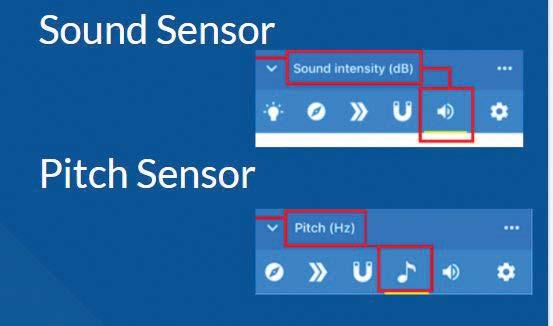
by Christina Bakoyannis, Middle School Science Faculty
Teaching science in the classroom involves stu-
Journal App. Students first demonstrated some of the experiments during a synchronous session and then were asked to pick one that they can complete during their asynchronous time. The experiments included: investigating the pitch changes when adding water to a glass or when playing a musical instrument such as the piano, testing the loudness of various actions using the sound intensity sensor and testing how loudness changes with distance (Fig. 2).
To achieve a deep and meaningful learning experience, the social presence needs to intertwine with the cognitive presence. Student interactivity with both the concepts and with their classmates was designed through a moodle discussion forum. When posting on a moodle forum, students are given the criteria of delivery, expression, contribution to one’s learning in the learning community and posting a comment to another student response (Fig. 3). Students presented their data collection during a synchronous lesson as well as posted their data in the moodle forum. Students replied to the data posted by their classmates by “Being the Scientist” and analyzing the data and providing scientific explanations (Fig. 4). This way, students were asked to make sense of data presented to them, while looking at another


Figure 2: Data Collection with the Google Science Journal App sensors investigating the pitch of the water level in a glass, the notes played on piano and the sound intensity as the distance from the source changes.
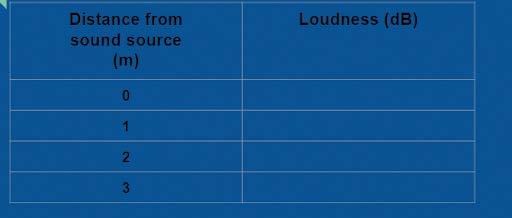
students’ data.
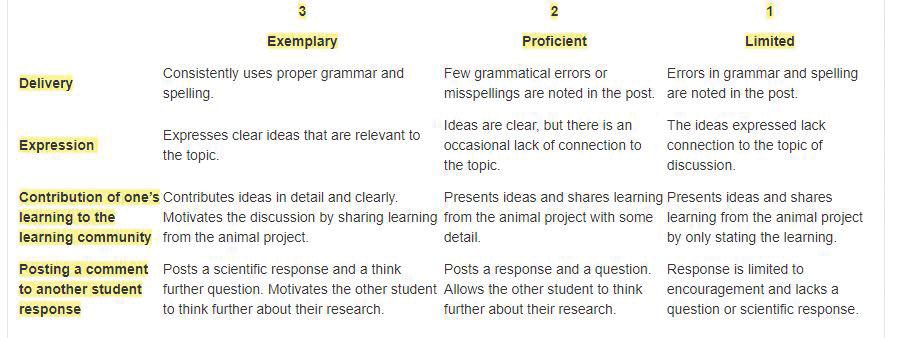
This makes sense. The less water in the glass, the faster the glass vibrates and the higher the pitch. Adding water to the glass decreases the amount of air space, which means there is less air to vibrate. What is strange is how little the pitch changes in Hz between 1.5 and 4 cm of adding water. I would expect it to change more.

Figure 4: Data collected investigating how pitch changes with the water level in a glass. A classmate posts a response giving a scientific explanation for the data collected.
As teachers, we aim to find ways to craft the webbased instruction in such a way in order to allow for the learning process to take place successfully while also fostering collaboration. Students not only need to be able to work independently in a flexible manner completing scientific exploration, but also to be able to interact with other classmates and the content. Furthermore, teaching students to communicate with each other in an online environment and giving them the questions and criteria to guide their thinking process can enhance the outcome. The overall goal is to strive for building a positive classroom culture. Students feel the sense of community and belonging as they know that when they post something on a forum, it is read and remembered. It can also serve as a way for students to go back to the post and read it again, thinking through the learning process and questioning further. In essence, it is about understanding that scientific inquiry does not end with an experiment, but that this is just the beginning of an ongoing process of questioning and making sense of phenomena around us.
ETHOS • FALL 2020 ScienceMaths

Virtual Learning 2020: A Learning Experience

by Dora Andrikopoulos, Middle School Mathematics Faculty,
The COVID-19 pandemic resulted in schools shutting down all across the world. Globally, over 1.2 billion children were out of the classroom, including, of course, the American Community Schools of Athens (ACS).
Our teaching methodologies had to almost instantly be adjusted to meet the needs of our students learning from home. It felt like education had changed dramatically, with the rise of virtual learning, where teaching was transferred to our Moodle platform with the use of Big Blue Button (BBB).
Having done some research myself on if online learning has been shown to increase retention of information, I started to feel a little more optimistic about the outcome.

Informative after class hours like Geek Hour and oneto-one meetings through Google Meet with our technology experts helped considerably with a smooth transition through each of three phases of online learning between March and June.
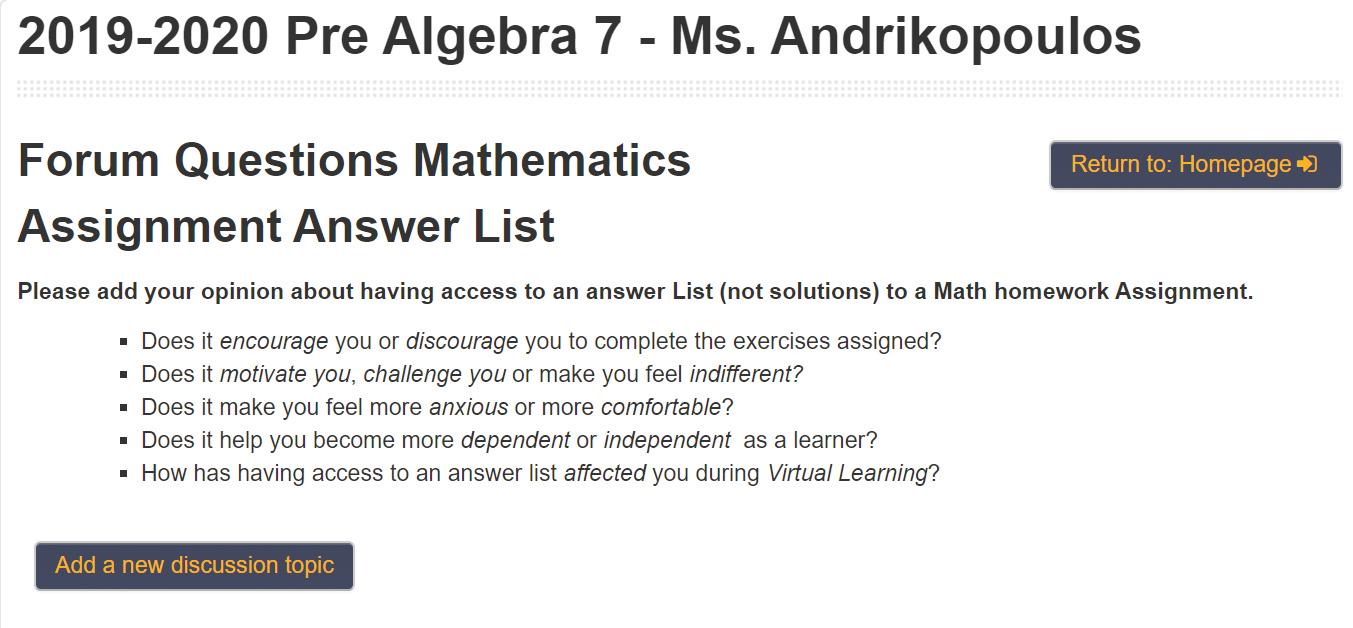
As the days went by, it was evident that not only were our students able to follow lessons and complete assignments during and after their virtual classes, but they also showed interest in wanting additional sessions to either clarify their understandings of content or for guidance into further independent study. Seeing students become flexible, more autonomous learners through this virtual learning model was quite satisfying.

There were, however, challenges to overcome. Some students without reliable internet access struggled to participate. We then needed to arrange additional asynchronous times to meet and go over essential sections of the learning content.
Assessment was another critical factor that needed to be considered seriously. Through Moodle and Google Form assessments, oral presentations, and Forum Discussions and reflections, students were assessed systematically throughout the entire process. This helped students check their progress and us as educators to monitor the effectiveness of knowledge delivery.
Through my research and personal experience during the COVID-19 pandemic, I believe that despite the rapid move to virtual Learning with very little time to train and prepare, a new hybrid model of education emerged. I also believe that this new hybrid model will result in a rich experience with significant benefits that is conducive to sustained growth.
Virtual Learning, has undoubtedly changed the way of my teaching. It has enabled me to reach out to my students more efficiently and effectively through chat groups, discussion forums, video meetings, breakout rooms, and also document sharing. My students found an effective and smooth way to communicate with me while on or off BBB.
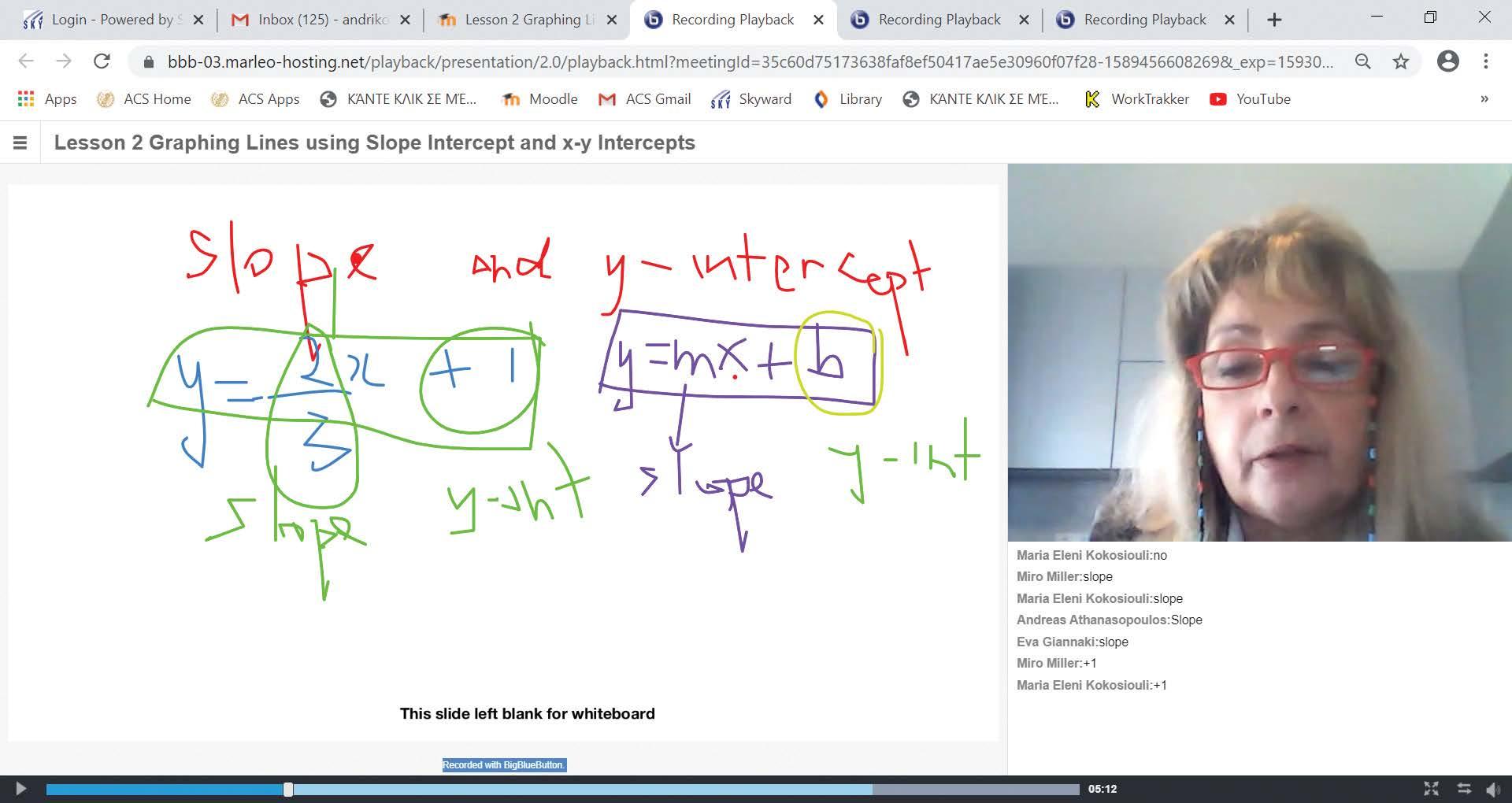
There is evidence that learning online can be more effective in several ways. Some research shows that, on average, students retain 25-60% more material when learning online compared to only 8-10% in a classroom. This is mostly due to the students being able to learn faster online; e-learning requires 4060% less time to learn than in a traditional classroom setting because students can learn at their own pace, going back and re-reading, skipping, or accelerating through concepts as they choose. Studies have shown that children extensively use their senses to learn, making learning fun and effective through the use of technology. We have observed that clever integration of games has demonstrated higher engagement and increased motivation towards learning, especially among younger students, making them truly fall in love with Learning.
I did observe that a good number of my students who had trouble focusing and performing during regular classes, were much more successful during virtual Learning. more easily distracted. To get the full benefit of online learning, there needs to be a concerted effort to provide this structure and go beyond replicating a physical class/lecture through video capabilities. Using a range of collaboration tools and engagement methods will promote “inclusion, personalization, and intelligence”.

What has been made most apparent to me throughout this time is the importance of disseminating knowledge clearly to our students. If a virtual learning model can play a role here, I am more than curious to explore its full potential.
As Wang Tao, Vice President of Tencent Cloud and Vice President of Tencent Education says, “I believe that the integration of information technology in education will be further accelerated and that online education will eventually become an integral component of school education.”


profound way. Within weeks, days, hours, the face of teaching and learning was remolded. New teachers, seasoned teachers, young and old, science or language arts, went from the good old, brick and mortar classroom, to becoming entirely virtual. Online instructors may have trained years to do what “regular” teachers did overnight…and they did it well! ACS Athens faculty were faced with a challenge, and with the support of the entire community and their own dedication to teaching and to their students, they made the impossible, possible. Teachers and students who take part in online courses know what to expect; teachers are trained and students are enrolled knowing very well the dedication, time commitment, and motivation needed. But what of 10 and 13 year-olds who all of a sudden went from learning side by side with teachers and friends, to continuing their learning within a virtually unknown realm? Much was asked from students; to adapt overnight to learning that needed additional self-discipline, and independence. Could you ever have imagined a day when a 2nd grader would take part in a synchronous online breakout room? A 4th grader would learn their fractions by watching their teacher on their computers? For two months, K-12 students became online learners; something that is normally experienced by students when they enter university. Think about what this means. For the next decade or so, students who enroll in online classes will already have had hours of experience learning online. How will that affect online teaching? More importantly, how will that even affect face-to-face teaching and learning?
With hard work and perseverance from all constituents, ACS Athens adapted to this new reality and committed itself to make it happen, to make learning happen no matter the circumstances. Years of training and commitment to i2Flex, inadvertently prepared ACS Athens Faculty for what came. Teachers took whatever training they had received and transformed their face-to-face classrooms, into virtual ones. They dedicated themselves to being “present” so as to try and minimize the loss of being socially distant. They knew that they could not lose touch with students. And students did their best to continue to maximize on their own learning with the tools given to them. But, where do we go from here? Education is continuously changing, constantly adapting to philosophies and methods. Still, this sudden change from face-to-face to online learning was unprecedented and will have long-lasting effects on K-12 education for many years to come. No matter the changes, no matter the face that education will take, ACS Athens and its community will be there to learn from their past experi-
by Labrini Rontogiannis, Academy Faculty, Virtual Classrooms and Technology Integration Coordinator
Now more than ever, education is changing in a

ences, take on the challenge and thrive.

Facilitating Learning During The COVID-19 Pandemic. Teaching Greek Language Arts In Middle School

by Maria Anna Sidiropoulou, Faculty of Greek Language and Literature
Introduction Indisputably the pandemic, together with the health crisis, has shaken and significantly affected societies and their economies. The accomplishment of the Sustainable Development Goals (SDG’s) has been hindered, while the educational systems worldwide have to cope with the emerging learning inequities through flexibility and the development of online courses. However, there are differences between a well-structured online course and one created hastily, under a global threat. Bibliography provided a theoretical background on how to support students and their learning during the crisis and we share our practical experience and what actually worked in dealing with the challenges the pandemic imposed and secure the undistracted continuation of our students’ learning. To effectively respond to these challenges, we did not deviate from the i²flex methodology as applied in our Institution but we opted to enhance the presence of the CoI framework (Garrison, Cleveland-Innes & Fung, 2010), to maintain student interest and engagement and expand the learning process. This blended learning practice not only provides the tools to form a reflective learner, but also supports the educational process in times of crisis. However, the recent updates in educational objectives prior to the appearance of the Covid-19 threat, have already offered further enrichment with technology-supported practices in helping the digital native student (Prensky, 2001, as. cited in Avgerinou & Gialamas, 2016, p.137) to meet the challenges of the 21st century. At ACS Athens the educational Global Morfosis Paradigm (gMp) is applied and consists of the Morfosis Educational Philosophy, the i²Flex Instructional Methodology and the Aristeia Leadership (Gialamas & Pelonis, 2009; Gialamas, Pelonis & Medeiros, 2014; Gialamas & Avgerinou, 2015) inspiring faculty on a daily basis to apply innovative teaching practices. Changing to online teaching, aka Emergency Remote Teaching-ERT (Hodges, Moore, Lockee, Trust & Bond, 2020) at ACS Athens did not cause panic and the transition was smooth, since the existing teaching methodology was already applied in the courses, whereas the involvement in the Virtual School Training Program provided the tools to effectively navigate this new educational space. Consequently, the most important points were coping with the challenges of online teaching and, mainly, re-design the course.
1. The online teaching challenges and our response Online teaching is associated with open-learning, as it aims at making the learner more self-determined and independent, while the teacher tends to become a learning facilitator (Wiki, 2020). Nevertheless, it also causes great concerns, the greatest one being associated with physical isolation. We had to teach our teams from a distance for two months; maintaining the bonds and enhancing students’ learning motives in order to raise their personal commitment and responsibility towards learning was an objective that sparkled a great deal of thought. Synchronous teaching via the BBB (Big Blue Button) sessions with breakout rooms and activities breaking the boundaries of physical distance was a primary treatment. However, we had to make up ways to deal with physical isolation and create the impression that the educator was indeed present. Therefore, we set up circles of Gmeets not only to discuss the students’ learning pace, but also to share discussions and connect with the students. Transferring the teaching/ learning responsibilities to the learner (Goode, 2007) was dealt with in a variety of ways, which are described below. Technical difficulties were an important concern as well, but, as the IT staff rushed to their treatment, we had issues such as internet connectivity, communication and structure of moodle shell resolved fast. In our case, teaching flexibility raised a series of questions, some of which are shared below:
At what moment do we believe that learning is taking place in an online course and what kind of support is provided to students? Learning definitely took place during the BBB sessions, but students could learn at their own pace. Therefore, we posted Pages (Table 1) on moodle shell weekly, to support curriculum delivery and meet learning needs and created a list of Homework- Assignments (synchronous and asynchronous) that included Checklists for time and learning pace management. Moreover, checklists helped us identify procrastination, monitor students at risk of failure, and take necessary proactive steps, e.g. reminders, e-mails to students and parents, scheduling Gmeets or proceeding in cooperation with faculty support, such as the OLP Department. When students encountered difficulties, appropriate encouragement and effective, timely provided feedback became our main means of issue resolving. Lacking communication by means of body language, we had to be extremely clear when providing instructions, while the teacher’s invisibility was somehow resolved by leaving the camera on.
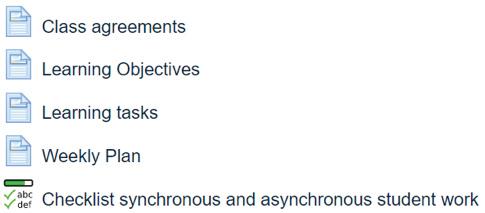
Table 1: Weekly picture of Moodle shell

What to learn and how? We had not only to choose the curriculum’s most essential elements for in-depth teaching, but also to support learning with activities meeting the CoI framework, that is the student-student, student-teacher, and student-content presences. Apart from creating Shared drives, where the material of synchronous and asynchronous sessions was posted, extensive usage of the following moodle features and other tools (Table 2) was made.

Table 2: Moodle Features and CoI Framework
The learning material was designed in a variety of ways; for example, we used Screencast-o-Matic and Audacity to produce audiovisual material and support learning of grammar in asynchronous sessions for our Greek LA 7-8 courses and Youth-to-Youth Program. Students before or after class could watch the videos and then proceed to practice through worksheets, google forms, external online practice from the Institute of Educational Policy (Ellinikos Politismos) and moodle formative quizzes. We also used the Book (Greek LA 8) to simplify the content and posted worksheets, ppt’s and further material in the shared drive. Another support tool was the TedEd; through the Watch and Think tasks, the students of the Youth-to-Youth Program listened to a song, filled in questions with gaps and learned grammar (adjectives, imperative of verbs), vocabulary and practiced listening skills (Appendix 1).
What instructional approaches and learning strategies could be offered online? Following the i²flex methodology in individual, collaborative, or in study groups offered significant differentiation of learning approaches. At first, direct instruction was carefully articulated to ensure the active participation of students. Thus, we had to enhance our lectures with qualitative brainstorming, well-organized material, and ask questions regularly so as to engage students into discussion. Extensive utilization of discussion was made either in synchronous sessions during the BBB chat and breakout rooms, an element that raised the level of interactivity too, or in asynchronous time via the moodle forums. It was also astonishing to see that the students’ assistants cooperated exceptionally well with our Youth-to-Youth Students with the breakout rooms.
Another indicative example of flexible learning was when our Greek LA 7 students completed the face-to-face activities of comparing innovative educators of different eras (Delmouzos in Greece, Célestin Freinet in France and Ran Clark in the U.S.A.) with a Debate and simulation of Delmouzos’s Trial. The students chose and took over the roles of the protagonist, prosecutor, advocates/ attorneys, witnesses. An example of how the Art Gallery and Optic Approach (Sidiropoulou, 2017) supported learning is through the Movements of Art Project for Greek LA 8, which was connected to the Component of
Language. After three synchronous sessions, students researched, individually and in groups, the Art movements in painting. They presented the most characteristic painters of their favorite movement and their work and commented on paintings appealing most to them. The last phase of the Project required an Art Craft (Appendix 2) by students, which should display the typical characteristics of the Art movement they had discussed. We had to continue providing students with clear instruction to minimize possible misunderstanding with regards to the steps they had to follow. The instruction was delivered through Moodle shell and other resources were posted, in order to limit the time-consuming access. Thus, students could access WikiArt, Google Arts and Culture & The art story.org, in order to support their inquiry and research-based project (Appendix 3). Likewise, the research-based assignments provided our students with chances to navigate the internet and explore resources for the Byzantine History Project.
Which friendly learning tech tools to use in a constructivist teaching online methodology? Students process information and construct knowledge in an individualized manner, collaboratively and, primarily, through taking over active roles (Mayer, 1992). Since students don’t live in sterilized social contexts, social influences offer them tools for knowledge construction through interaction. Within a collaborative environment, the intervention of technology cannot be overlooked since, according to the SHiFT research “students do better if they combine part of their learning in an online classroom with those who learn fully in the traditional way” (2013, as mentioned in Avgerinou & Gialamas 2016). Taking into account the definition for the hybrid learning model as provided by Graham (2006, cited in Avgerinou & Gialamas, 2016), blended learning combines learning activities related to live educational planning, real classroom conditions, and online guidance. If the discussion addresses the dynamics of distance learning, then additional dimensions enhancing pedagogical practice appear: social interaction, presence of the teacher, student interest-motivation, content, and learning outcomes. In our case, the attempt to classify the learning tools (UNESCO & IRTCRE, 2020), in order to assure both real-time feedback and formative assessment resulted in the following categories:
Tools to produce resources and material: Moodle, moodle quiz and forums, Screencast-O-Matic, Audacity, PPT, Cam scanner (in rare cases)
Tools for synchronous sessions: BBB, breakout rooms, chat, google docs and google forms, ppt-presentation, moodle forum-quiz ing: moodle forum-quiz, google forms, flipgrid, google drive/ docs, TedEd, mind mapping,
2. How to enhance the CoI framework during the pandemic in Greek LA Courses The CoI model combines the social, teaching and cognitive presence into an indivisible unity, where each component influences equally the other and forms the necessary prerequisites for a qualitative learning experience. Each presence consists of certain parameters; teaching presence includes design and organization, directed facilitation, and facilitated discourse (Anderson, Rourke, Garrison & Archer, 2001, p. 3). Four phases define the cognitive presence: triggering event, exploration, integration, and resolution (Garrison, Anderson & Archer, 2001) while the concept of social presence is defined as “the person perceived as ‘real’ in mediated communication (Gunawardena and Zittle, 1997, p. 4) and predicts the level of student’s satisfaction. The i²flex methodology builds the sense of community as “a feeling that members have of belonging, matter to one another and to the group, and a shared faith that members’ needs will be met through their commitment to be together” (McMillan, 1976 as cit. in McMillan & Chavis, 1986, p. 9). A strong learning community then is one with a high level of connectedness. If we take into account the different communication patterns (Belenky, Clinchy, Goldberger & Tarule, 1986), it is within the CoI model that cooperation is prioritized, and a collective connected voice is heard.
What follows are examples of how we applied and tried to enhance the three presences of CoI framework during the virtual classes since the beginning of the Greek lockdown. The Greek LA Courses consist of three different components: Language, History, and Literature. As per course design, each component is taught in close relation to the other and the topics under research or discussion are examined on an interdisciplinary basis. For example, through the Byzantine History assignments and activities, we practice different writing skills.
Each example displayed reflects activities that took place on a weekly basis or were completed within two consecutive weeks. Students were working individually before or after class and in groups, in synchronous or asynchronous mode.
Example 1: Greek LA 8, Byzantine History, Unit: Crusades and Constantinople Sacks & Grammar, Unit Subordinate Clauses
Objectives: 1a. Develop arguments in relation to topics of the Crusades and the Sacks of Constantinople in 1204 and 1453
1b. Evaluate the causes and effects of the two Constantinople Sacks
3. Familiarize with moodle quiz and the essay question as a proactive step to online final assessments
4. Distinguish and use subordinate clauses in written or oral speech
Tools to support activities and Assessment: moodle url, formative quiz, forum, dialogue (where applicable), google doc and forms
Summary of Activities: after a poll on BBB and the synchronous brainstorming activity (google form), the teacher showed a short presentation on the BBB screen, while questions were addressed that sparked discussion. Students exchanged points of view in the chat and shared notes, but could also unmute their micro. Subsequently, in the BBB breakout rooms, team-work required students to discuss and post answers on assigned questions in a google doc or ppt, which was presented and discussed, when the class returned as a whole to the discussion. After the conclusions, students proceeded to work individually and in asynchronous pace, i.e.:
Enhancing the Student-Content presence: we divided the documentary “The Sack of Constantinople” (webtv.ert.gr/ert1.myxani-tou-xronou) into three parts, each one with distinct content. This division assisted in organizing the discussion forum topics. A moodle quiz followed each part and required students to have watched the video and reflected on questions before answering. Instant feedback was posted for each question. Apart from the url’s posted on moodle shell to support the grammar component, additional material was posted on Pages as Related Readings and Other Resources and summative moodle quizzes underlined the closure of all units.
Enhancing the Student-Content and Student-Student presences: three discussion topics were posted in relation to the above documentary sections. Students worked in two phases. At first, we formed two different student groups, each one with a different reflective question to answer. Each student posted his/ her answer based on a Rubric/ Criteria of Assessment to check Content-Expression-Organization of Ideas. The teacher provided individual feedback on a google doc to avoid influencing the peers in their assessment, which was requested in the second phase. Where assigned, peers provided feedback based on Peer Assessment Rubric. After the completion of this phase, the students resubmitted their answers, which they improved on the basis of the feedback they received from their peer and teacher. The teacher evaluated students for both their posts and the quality of feedback they provided.
On the same base, students worked on similar forum posts supporting the extension of reflections on the topics under discussion (Sack of Constantinople in 1204 and 1453) but through the component of language and rammar. For example, the song of Professor Helene Glykatzi-Ahrweiler was one of the prerequisites to analyze one of the forum questions. Likewise, students evaluated the content and practiced the Subordinate Clauses/ Supplementary Sentences of Constantine Palaiologos’s speech about the eve of the city’s sack by the Ottomans.
Example 2: Greek LA 7, Ancient Greek History, Unit: Architectural Orders and Pottery & Language, subchapter Distant Education & Grammar, Unit Pronouns and Adjectives
Objectives:
1. Participate in online discussions
2. Ancient History:
Recognize and explain the two decoration styles in ancient pottery
Identify features of pottery in Classical times
Identify, describe, and comment on the features of architectural orders
Compare types of pottery
Explain and justify (arguments and evaluation) points of views
3. Language/ grammar:
Practice and revise grammar, so as to proceed to summative assessment (quiz)
Reading texts and answering questions, justifying points of views
Tools to support activities and assessment: moodle url- Quiz-Art Gallery- Forum, google doc
Summary of Activities: after a verbal poll in BBB and the synchronous brainstorming activity, the teacher showed a short presentation on the BBB screen, while questions were addressed that spared discussion. Students exchanged points of view in the chat, verbal discussion, and shared notes. Then, in the BBB breakout rooms, team-work required students to work on grammar exercises. Before the synchronous session, students had watched the material prepared with Screencast-o-Matic. As a whole, the class shared their answers, creative usage of mistakes took place, and the necessary feedback for improvement was provided. After the completion of this task, we proceeded to the history component making use of the Art Gallery, the booklet prepared, and a url in relation to famous buildings featuring elements from the ancient Greek architectural orders from all over the world. After revising and commenting on this part, students had to work through the Forum and a formative quiz. Three different content questions required a combination of observation skills, reading
and listening comprehension, small-scale research on the architectural orders by using the provided url and other sites, if students wished, and exposition of points of view. In asynchronous time, students would work on a Language Forum and the topic of Distance Learning. After watching a video, they were asked to post their answers and justify their points of view. The forum activity was completed with peer assessment based on assessment criteria. Το assess the answers, a sample analysis of the posted answers and the peer feedback was made by the teacher, while corrections and improvements were suggested in collaboration with the students.
Enhancing the Student-Content presence: following the course design, additional material was created to support content comprehension. We opted not to use the Book moodle feature, as it was possible to attract limited student interest. Instead, booklets with pictures followed by short paragraphs and the Art Gallery could serve our purpose. The Art Gallery consisted of images associated with the Greek architectural orders from the sites usa.greekreporter.com and ehow. com. Students could describe and comment on the famous buildings while making connections to the material previously discussed. There were three forum discussion topics that the students would work on individually at home as written tasks since the writing process is one of the main course objectives. Each one required different skills such as observation, reading and listening comprehension, small-scale research, and justification of arguments. After the completion of the forum posts, the students received the teacher’s written feedback and proceeded in a formative moodle quiz, where each question received instant feedback. The Grammar component was revised through a formative quiz, and students could access the audiovisuals and exercises from the shared doc, prior to their attempts.
Enhancing the Student-Student and Student-Teacher presences:
This was covered through forum activities. Different topics of discussion asking students to watch a short video and post their answers to two questions related to distance learning were posted. Students had to reveal their own views and comment on the views presented in the video. The second forum discussion topic required reading comprehension and vocabulary enhancement tasks. After the completion of the assigned activities, students had to provide feedback to their peers’ posts following the assessment criteria. Apart from the teacher’s individual feedback to the answers, a sample analysis of the posted answers and the peer feedback was made by the teacher and corrections and improvements were suggested in collaboration with the students. 3.Reflections Teaching online during the pandemic was indeed an experience that promoted flexibility in designing daily lessons and adapting teaching practice to the emerging challenges. Based on observations, the teacher’s diary, and students’ feedback, we believe that from the students’ point of view, what worked effectively was the learning engagement and motive, especially for our 8th-grade team.
The students experienced a high level of satisfaction working at their own pace in asynchronous time, and with the extension of submission until 20.00 or 21.00 pm, their time-management skills gradually improved. The level of familiarity with i²flex methodology and moodle shell was maintained for the 8th-grade team and increased on a daily basis for the 7th-grade teams. Another encouraging result is the fact that the different formative assessment tasks met the curriculum objectives; the moodle formative quizzes supported effective self-assessment. Multiple attempts at formative quizzes enabled concept negotiation too. In general, the student-student and student-teacher presences were daily met and we could see the majority of students developing social competence and resilience. However, the passive observation of peers’ posts by a percentage of students on the Forum and sometimes the reproduction of similar answers, make reflecting and attempting to come up with more ways to restrict this case imperative. Even if we smile with a portion of students’ future learning (Thomas et al, 2011) or feeling content with raising the level of equity in class participation on behalf of the shy students, the question of how effectively OLP students worked for their own learning and contributed to collective learning remains thorny. We had a steady rate of missing posts and peer feedback, and a month later the number of posts and level of collaboration had reduced dramatically. However, the close cooperation and support by the OLP department facilitated many of the missing tasks and the preparation for the final quarter assessment. Lastly, peer assessment is another area of growth. Even if it worked for the 8th-grade team, as their level of maturity and familiarity is higher, it seems that regular practice and responsible commitment to this role required empowerment as far as the 7th grade teams were concerned. The quality of feedback from teachers and students is a process requiring constant F2F and online monitoring, but the management of the time invested by the teacher can be strenuous. Repeated meetings with students who could not keep up with the pace are helpful, but we must keep in mind that constant motivation renewal is necessary. The forum was appealing, but there is always the danger of a drop in student interest, as a result of its systematic use; thus, we are always in need of additional ideas for student interactivity.
In regards to the teacher’s part, changing the role into a facilitator and moderator raised the level of students’ self-expectations, and we were proud to see them taking over a more responsible role in their learning, one of the prerequisites of an effective online course. It was apparent that the 8th-grade team, with few exceptions, worked with conscientiousness and did not lose
their learning pace. The formative assessment required careful selection between activities and skills to be developed, but this allowed us to also carefully choose the most important components for in-depth teaching. Perhaps the preparation of the necessary activities and moodle quizzes is time-consuming, but in the long run, this activity builds a resource bank, ready to use at any time. What would enrich and add originality to the course would be to include more interactive tools, thus enhancing each of the CoI presences. Our ultimate objectives include the continuous improvement of OLP students’ motivation and alertness to monitor peer assessment; the quality of individual feedback and peer work is a constant objective in online and synchronous teaching. As far as the objectives are concerned, we feel that the CoI framework presences are a dimension that worked well during online teaching. Although the pace of curriculum coverage might have been slower for the 8th-grade team, we feel that we preserved a good level as far as the writing process is concerned. Primarily, the activities engaged students to apply and evaluate knowledge, rather than simply comprehend it.
Conclusion There are plenty of reasons for the pandemic-prompted shift from live synchronous teaching to online; a true venture that educators had to deal with to be sure. This immense challenge forced educators worldwide to adapt and transform their teaching practice overnight. Although student learning was severely disrupted, learning in a safe environment has been the main priority of every public or private educational institution. The Covid-19 threat represents another crisis to manage, and it is within crises that innovative solutions usually emerge; education leaders reflect on learning continuation by either incorporating already existing alternative learning methods or addressing online learning. However, perhaps we do not need a pandemic to alter our teaching methods and learning approaches. If we take into consideration that we live in a digital era where education is not sterilized by technology intervention, then we welcome alternative and progressive methodologies that combine synchronous with distant and self-paced inquiry learning. Our experience concludes that to secure the effectiveness of such an endeavor, the application of the CoI framework requires paying similar attention to each of its presences. Among the presences of the framework in the online learning, rarely will an educator slip to the negligence not to enhance the student-content or student-teacher dimension. It is mainly the enhancement of the student-student presence that makes the difference in the quality of interaction. The question is then transformed into which kind of activities and supporting tools are the most effective in expanding student learning and motivation. This is a question that educators need to answer every day.
■
References Anderson, T., Liam, R., Garrison, D. R., & Archer, W. (2001). Assessing teaching presence in a computer conferencing context.
Avgerinou, M. D., & Gialamas, S. P. (2016). The i2Flex Methodology: Definition, Praxis, and Conditions for Success. In Revolutionizing K-12 Blended Learning through the i²Flex Classroom Model (pp. 135159). IGI Global.
Belenky, M. F., Clinchy, B. M., Goldberger, N. R., & Tarule, J. M. (1986). Women’s ways of knowing: The development of self, voice, and mind (Vol. 15). New York: Basic books.
Garrison, D. R., Anderson, T., & Archer, W. (2001). Critical thinking, cognitive presence, and computer conferencing in distance education. American Journal of distance education, 15(1), 7-23.
Garrison, D. R., Cleveland-Innes, M., & Fung, T. S. (2010). Exploring causal relationships among teaching, cognitive and social presence: Student perceptions of the community of inquiry framework. The internet and higher education, 13(1-2), 31-36.
Gialamas, S., & Avgerinou, M. D. (2015). Aristeia Leadership: A Catalyst for the i 2 Flex Methodology. Educational Policy Analysis and Strategic Research, 10(1), 13-23.
Gialamas, S., & Pelonis, P. (2009). Morphosis leadership being visionaries in a changing world. Academic Leadership: The Online Journal, 7(2), 10.
Gialamas, S., Pelonis, P., & Medeiros, S. (2014). Metamorphosis: A collaborative leadership model to promote educational change. International Journal of Progressive Education, 10(1), 73-83.
Goude, S., Willis, R., Wolf, J. & Harris, A. (2007). Enhancing IS Education with Flexible Teaching and Learning. Journal of Information Systems Education, 18(3), 297-302.
Gunawardena, C. N., & Zittle, F. J. (1997). Social presence as a predictor of satisfaction within a computer-mediated conferencing environment. American journal of distance education, 11(3), 8-26.
Hodges, C., Moore, S., Lockee, B., Trust, T., & Bond, A. (2020). The difference between emergency remote teaching and online learning. Educause Review, 27.
McMillan, D. W., & Chavis, D. M. (1986). Sense of community: A definition and theory. Journal of community psychology, 14(1), 6-23.
Mayer, R.E., (1992). Cognition and instruction. Their historic meeting within educational psychology. Journal of Educational Psychology, 84, 405-412
Mayer, R. E. (1992). A series of books in psychology. Thinking, problem solving, cognition (2nd ed.). W H Freeman/Times Books/ Henry Holt & Co.
Sidiropoulou, M. (2017). Applying the Aesthetic Experience in Teaching a Greek LA Literature and Language Course in a multicultural environment. Ethos, Vol. 12 (1).
Thomas, G., Martin, D., Pleasant, K. (2011). Using self and peer-assessment to enhance students’ future learning in higher education. Journal of University of Teaching & Learning Practice, 8 (1), 5
Wiki(2020).Open learning. Retrieved from: https://en.wikipedia. org/wiki/Open_learning
Appendices 1. Using Screencast-o-Matic to support Grammar for Greek LA 7 and Youth-To-Youth Program and TedEd for Youth-To-Youth Program 2. Last Phase of Movements of Art in Painting, Student’s Artwork (I.P.)- Greek LA 8 3.Indicative resources to support the Movements of Art in Painting as posted in the Moodle Page, Greek LA 8




The Middle School Honor Code Club At The “Mila Tora” Campaign Organized By “The Smile Of The Child” At The Greek Ministry Of Education

by Venie Gaki and Christina Bakoyannis, Middle School Faculty
The Honor Code Club has long been recognized in ACS Athens, and ever since it was founded, its members have been involved in many initiatives. For the past two years, our focus has been on inclusive education and creating a place that everybody calls “home”. Panhellenic action against school violence and bullying, an event that was organized by “The Smile of the Child” and held at the Greek Ministry of Education.
The event was called “Mila Tora” (Speak Now), and it united student voices to spread their own messages and raise public awareness against this phenomenon. According to UNESCO, Plan International suggests that approximately 264 million children and adolescents experience some form of violence or harassment, either verbal or physical, in and around school every year. As this phenomenon is clearly a violation of one of the most fundamental human rights, as the right to education is enshrined in the United Nations Convention on the Rights of the Child, our students were inspired by Martin Luther King’s speech “I have a dream…”, delivered at the march to Washington in 1963. With their speech, they intended not only to raise awareness but also suggest ways to eradicate discrimination, prejudice, and exclusion and measures to ensure equal treatment and promote inclusion.
Kosmas Drakopoulos, Antonis Nikoletopoulos, Anna Pruess and Themis Soukakou, four of the most active and dedicated members of the ACS Athens Middle School Honor Code Club gave a powerful speech in both English and Greek in order to promote the club’s motto “Students inspiring students to do the right thing.”
The Middle School Honor Code Speech, as delivered on March 6, 2020, within the MILA TORA campaign at the Ministry of Education:
“We are members of the Honor Code Club from the American Community Schools of Athens Middle School. We believe in helping students build character, learn to work together on a variety of projects, learn to be reliable and to live and promote values such as courtesy, resilience, respect, and concern for others. We work with charity organizations, and we put into action plans and projects to increase the well-being of the students in the ACS Athens middle school, and we have a dream. We dream of a safe and friendly school environment where students can develop positive relationships and feel included.
In order to achieve this dream, we have done work to educate ourselves and others about various forms of bullying, cyberbullying, and social exclusion. Last year, we sent out a survey to all the students in MS, we analyzed their answers, and we decided that we will continue to take action. We are planning a middle school volleyball tournament to grow and strengthen a sense of community among the students and remind them that we are all on the same team, and we need to support each other and not bring each other down. We are also going to collaborate with another club in the school to produce a video that will raise awareness of the issue we are here for.

Our ACS students delivering their powerful speech “I have a dream...”
we’re all going through the same things and working for the same goals.
According to the International Bullying Prevention Association, “many of our children and young people will experience the most powerful positive childhood experiences at school. Our priorities in schools must be to establish, strengthen, and maintain a sense of safety and a sense of community first. Safe and supportive schools are fertile ground for student learning.” So, we have to find ways this can become a reality in every school. And this is why we strongly support the initiative “MILA TORA”.
We have a dream...We want to inspire students who have bullied others to STOP IMMEDIATELY. There are other, better ways to deal with the problems they may be experiencing in their lives, and we want to help them find those better ways and keep their classmates away from harm. Schools are great places to build and learn to understand relationships, and those relationships make a large impact on the mental health of these people when they become adults.
We have a dream…..We believe that when passionate, intelligent, and proactive kids and teens gather together and work to make a difference, things can change.
We have a dream….to spread kindness and the message that mutual respect is the key to a healthy teenage and adult life.
We have a dream, and it is more than just a dream. It is a plan. A plan that is becoming a reality.
“Mila tora….”







